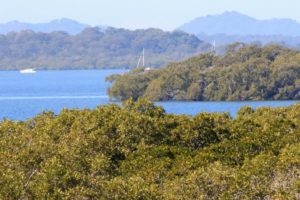
Mangroves fringe the shores of Moreton Bay
Many Redland residents know that the early explorer Matthew Flinders landed on Coochiemudlo Island. Locals and visitors alike are soon to celebrate this occasion. But fewer know that amongst Matthew Flinders notes are references to the vast mangrove forests which first greeted the early European explorers. So extensive were the mangroves that they obscured the mouth of the Brisbane River.
Moreton Bay-Quandamooka has a line of islands to the east, forming its seaward boundary. Extending from the Sunshine to the Gold Coasts the relatively shallow expanse of water is where the tropical and temperate waters meet, mingled with freshwater flows from six rivers and a number of creeks.
Its unique geography has led to the formation of diverse habitats – coral reefs, rocky, sandy and muddy foreshores – which in turn provide feeding and breeding grounds for thousands of species, some endemic.
Moreton Bay facts
Moreton Bay:
- has the highest recorded diversity and abundance of resident and transient whales and dolphins in Australia
- is the only place in the world where dugongs are found this close to a capital city
- supports six of the world’s seven sea turtle species and many shark and ray species
- annually attracts 32 species of migratory birds which join the resident bird populations
- has thousands of species of fish, molluscs and other invertebrates
- is an important recreation space for the people of SEQ
The Moreton Bay Marine Park was declared in 1993. Due to the environmental significance of these wetlands Moreton Bay-Quandamooka is a Ramsar site. These declarations and agreements are intended to guide our actions and to ensure survival of the bay’s biodiversity. But will it be enough?
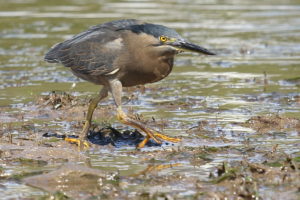
Mudflats are where birds like this striated heron feed
The mudflats exposed at low tide are exceptionally rich with myriad life – small worms, crabs and molluscs – an integral part of the food chain. They are not a barren, under-utilised wasteland waiting to be ‘reclaimed’ as some would have us believe.
Mangrove wetlands and seagrass beds possess an extraordinary number of stunningly beautiful animals, each playing an important role in the healthy functioning of the marine environment. Yet to some, they are merely murky, smelling, temporary impediments to development approvals. That this is the attitude of many who wield considerable power in land use planning and decision-making is perturbing.
Citizen scientists get muddy

Citizen scientists ready to get muddy Photo courtesy Julie Geldard
Counter to this, over the past year close to 100 Citizen Scientists, several being Redland residents have volunteered nearly 1,000 hours to the collection of data on seagrass and mangroves in Moreton Bay, its rivers and creeks.
Some may ask why seagrasses and mangroves are important, what’s driving these people to give up their time, to get onboard vessels or to slosh around in mud? The reasons are as varied as the participants themselves but a focus on seagrass and mangrove monitoring is due to these species being the ‘coastal canaries’ – they provide early signs of changes in the quality of marine environment.
The ecosystem services provided by seagrass include:
- buffering and filtering nutrients and chemical inputs
- stabilising coastal sediments
- providing food and shelter for many organisms including two iconic species, dugong and green turtle
- being nursery grounds for commercially important prawn and fish species
- storing carbon 35 times faster than rainforests
- locking carbon in for thousands of years
Despite these significant benefits 50% of Australia’s seagrasses have been destroyed by dredging and pollution. Resistance to the loss of seagrasses is strengthened by knowing that when it is exposed to the air, the sediment beneath seagrass releases greenhouse gases which compounds rising temperatures.
Similarly, mangroves are early detectors of change while providing multiple ecosystem services from which we all benefit. The mangroves are:
- filtering coastal pollutants
- trapping sediments which is protecting coral reefs
- essential habitat for species, including ‘our seafood’
- providing visual amenity and recreational opportunities
- highly effective and cost efficient carbon sequesters – locking 1,000 tons per hectare of carbon in their soils (more than three times as effective as tropical forests)
- protecting shorelines and valuable coastal real estate from erosion and storm surge (30 mangroves per 100 square metres in villages on India’s east coast reduced the maximum flow of the 2004 tsunami by more than 90 percent)
- a cost-effective alternative to built infrastructure for shoreline defence
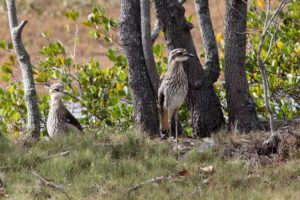
Saltmarsh area inhabited by bush stone-curlews
Mangroves, and their companion habitat tidal saltmarshes, are amongst the most endangered marine wetland habitats. Worldwide they are disappearing at up to two per cent a year on average.
The “Wild Guide to Moreton Bay” published by the Queensland Museum states:
It is vital that we all make the connection between the loss of bushland at the end of the street, the filling of wetlands or the channelisation of creeks, and the effect that this might eventually have on the health of the Bay. Each small act may seem insignificant in its own right; however when multiplied together they have a considerable impact.
The Minister for the Environment, Hon Greg Hunt MP will be pivotal in the fate of Moreton Bay-Quandamooka given that the Toondah Harbour proposal will require his Federal Governmental approval.
On 16th July the Minister is hosting the Threatened Species Summit which is claimed “will reinforce the new national focus on threatened species”. Will the appointment of a Threatened Species Commissioner, the adoption of his “Threatened Species Strategy” and a policy framework with measurable targets help the threatened and vulnerable species of Moreton Bay-Quandamooka? Time will tell and Toondah Harbour will be the test.
Lets hear it for mud!
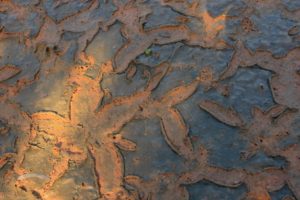
Patterns in the mud
Mud be in it
Mangroves love it
Seagrass grows in it
Insects and fish breed in it
Birds and crabs feed in it
And we should look after it.
Mudflat Arts
References and other reading
Peter Davie and others, Qld Museum. Wild Guide to Moreton Bay.
AMCS. Moreton Bay Marine Park.
Department National Parks, Recreation, Sports & Racing. Managing Threatened Species in the Moreton Bay Marine Park
National Parks et el. Moreton Bay Marine Park User Guide.
Asean Centre for Biodiversity. Mangroves, our insurance against the wrath of nature.
SEQ Catchments. The SEQ Ecosystems Services Framework
MangroveWatch
Wildlife Queensland Coastal Citizen Science
Toondah Harbour marina a Federal matter
Debra Henry
Project Officer, Moreton Bay
Wildlife Queensland Coastal Citizen Science
Conducting Seagrass-Watch and MangroveWatch in Moreton Bay
The views expressed are those of the author and not necessarily those of WPSQ.
Please note: Offensive or off-topic comments will be deleted. If offended by any published comment please email thereporter@redlands2030.net
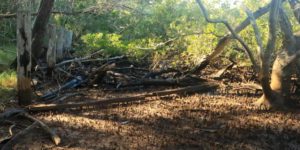
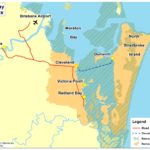
Are wetlands important? Not if a developer wants to fill & develop one as in Capalaba, i.e. 29-37 Moreton Bay Rd. under Special Protection in Koala Coast Policy, an ineffective policy, (zoning changed overnight to Commercial) as Council operatives and AWU State politicians ignored the 300+ petition presented to former LNP Govt Environment Minister Brian Littleproud, who required an EIS were approval sought to fill and build on this wetland site (Debra Henry & environmental scientist Lyn Roberts know the site). Change in Govt had new Minister Rod Welford waiving the EIS requirement so approval was given to Peter Endacott (on RCC’s Reference Group) to drain and fill the mini-crater with imported earth over a period of weeks preventing local residents use of the creek bank ..today a no-go zone as creek bank walkway is unwelcoming and considered dangerous to enter from 19 Crotona Rd units through to Moreton Bay Rd bridge, dark, with high walls filled with graffiti…an ideal environment for vandals. Koalas are no longer seen along Coolnwynpin Creek believed to be extinct. I cried after last meeting in council when this site was approved ..I drove to the wetland/bushland site, took photo of young koala reaching for leaves on neighbouring tree, and wept knowing all would die with major/core habitat destroyed..
Mud, mud, glorious mud.
When you know just how vital and precious this particular coastal environment is, it makes you wonder who could think of richly biodiverse Moreton Bay as an appropriate location for a Gold Coast development, replacing mangroves with a marina, and putting high-rise buildings onto water-logged land.
Thirty-five-odd years ago when the mangroves of Raby Bay were bulldozed for a canal estate, environmental awareness was primitive; perhaps the grossly ignorant developer and politicians could be excused. But now, when we know so much – and the environmental stakes are vastly more extreme – what is the excuse for removing any mangroves in Moreton Bay?
Build Cleveland’s Big Attraction not at Toondah Harbour but in Raby Bay. It’s north-facing and out of the prevailing south-easterlies, it has a kilometre of waterfront park, it’s walking distance from the CBD and train station – and it’s already been denuded of its glorious mangroves.